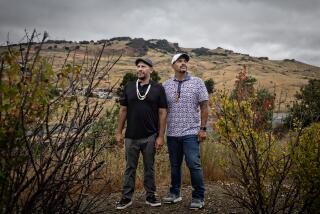Mohawks Seek to Save Language, Revive Culture : Native Americans: Dismayed at the commercialism and casinos, they bought 300 acres in Upstate New York to establish a traditional community.
- Share via
PALATINE BRIDGE, N.Y. — Tom Porter is shedding the white man’s “language of commerce.” As Sakokwenionkwas, he will make a new life in the valley of his ancestors, speaking a tongue with roots in nature.
“A year from now, I will speak only Mohawk,” he said. “I will be a living example to the young people.”
Porter, 49, is spokesman and spiritual leader of a group of Mohawks who have started a new community here in the Mohawk Valley, about 50 miles west of Albany.
He said they plan to live simply, in harmony with nature, in keeping with the traditions of their Iroquois forebears who were driven from this valley 200 years ago. It will be an “immersion community,” where Mohawks will steep themselves in the language, spirituality, myths, rituals, values and culture of their ancestors.
“Once a language dies, anthropologists say 50% of your values and traditions and culture dies,” Porter said. “Ours is a living language. If we are to keep it alive, we must speak it.”
Porter is a solid man with hair worn in a ponytail. He has a careworn expression and fleeting smile. He speaks softly, slowly, savoring stories of history and prophecy.
“This whole valley is the original homeland of my people,” he said.
The Mohawk is one of the six nations of the Iroquois Confederacy, founded by the legendary chief Hiawatha. The Iroquois lived in palisaded villages across New York state when Europeans arrived in the 1600s. They controlled a territory stretching from Maine to Michigan.
The Mohawk Valley, a major east-west trade and travel route in Colonial times, was a key battleground during the Revolutionary and French and Indian wars. The Mohawks had lived peacefully among the European settlers for more than a century. But Mohawk mercenaries, recruited by the British-educated Mohawk Joseph Brant, joined Tory massacres during the Revolution.
Bloody pay-backs by the Continental Congress forced the Mohawks to flee to their northern hunting grounds. Today, their descendants live on reservations at the Canadian border and in Ontario.
“There was a prophecy that one day, our great-grandchildren would come home to this valley,” Porter said. “So now here we have returned.”
“We call this place Kanatsiohareke (pronounced Ga-na-jo-hla’-ga). It means ‘place of the clean pot,’ ” Porter said. The word refers to the 12-foot-wide limestone potholes in a local creek bed. Nearby Canajoharie, home of Beech-Nut baby food, got its name from the same Mohawk word.
The settlement has been Porter’s dream for 25 years.
“There was a destiny for me, because of what my grandmother taught me--to keep alive the traditional ways of the Mohawk people,” he said.
He tried to do that at Akwesasne, the St. Regis Indian Reservation 200 miles north along the Canadian border, home to about 9,000 Mohawks. He grew up here. He built a home for his six children, raised horses, netted fish, grew fruit and vegetables. His wife, Alice, was renowned for her beadwork. They lived simply, without electricity or other “trappings” of the commercial world. They spoke Mohawk and Choctaw, Alice’s native tongue.
Porter served as an acting Bear Clan chief in the traditional longhouse government, which opposes the reservation’s state-sanctioned elected Tribal Council. He helped start the 13-year-old Akwesasne Freedom School, with an elementary curriculum taught in Mohawk.
But Akwesasne, “Land where the partridge drums,” has become poisoned, Porter said. The St. Lawrence River, which once fed the Mohawks a bounty of fish, is tainted with toxic compounds from industries upstream. The land, where Mohawks once had hundreds of farms and now have none, has been polluted by fallout from aluminum smelters and chemical plants upwind.
There is another kind of poisoning at Akwesasne, Porter said: a poisoning of the spirit, an erosion of cultural integrity. It comes, he said, in the form of bingo halls, cigarette smuggling, tax-free gasoline and casinos.
Gambling has stirred bitter disputes at Akwesasne between traditionalists, who consider it a vice that will destroy their people, and other Mohawks who say casinos are the key to their nation’s sovereignty and economic survival. Two Mohawks were killed in a shootout over the issue in 1990.
The first house Porter built was burned during an uprising in 1979. Two of his beloved Belgian horses were poisoned. Porter has been shot at and arrested. Two years ago, he suffered a heart attack.
Now, he and a band of like-minded Mohawks are making a fresh start at Kanatsiohareke, on a hillside overlooking the Mohawk River.
The Mohawks bought the 300-acre property for $210,000 at auction in July. There are three wood-frame residential buildings, a huge barn and auxiliary structures. The main house, built in the 1800s, needs many repairs.
A sparkling stream flows through a 200-acre forest and past the buildings. About 90 acres of tillable fields stretch to the river, which is framed by landmark crags called Big Nose and Little Nose.
Five families moved to the settlement last fall from Akwesasne and reservations in Ontario. More will come this spring. For now, they live in the rambling main house and share meals. One day they will build separate homes. The main house will function as the longhouse, the meeting place and social and religious center of the traditional Iroquois community.
They will seek to be self-sufficient, although some may hold outside jobs. Porter, who has worked as a cultural consultant for the North American Indian Traveling College in Ontario, plans a “pick-your-own” raspberry and strawberry farm. He wants to grow organic vegetables and raise beef cattle and perhaps buffalo. The community may raise trout in a “fish farm” along the creek or river.
There will be a shop selling books and native crafts, such as ash-splint baskets, moccasins, ribbon shirts and beadwork. Eventually, a learning center may be established for those who wish to study Mohawk culture and spirituality.
“We will attempt to get away from the idea of private ownership and competition among individuals,” Porter said.
“At Akwesasne, everybody’s out for themselves,” said Jayne George, 35, who lives at Kanatsiohareke with her three children. “Here, we’re a community, living together, working together. Everybody has a say. Everybody shares.”
The Mohawks had raised about $25,000 toward the land purchase by holding taco dinners and other fund-raisers at Akwesasne, and through donations, Porter said. They were able to keep that for living expenses when a group of private donors, who requested anonymity, put up the purchase price.
“It was a real surprise, a blessing,” Porter said. “They said the only repayment they want is for us to succeed, because the world needs examples like this.”
Other blessings have been bestowed on the Mohawk homesteaders. Neighbors bring food. Dozens of volunteers, including Albany college students, join weekend work bees. A church donated furniture. The sheriff came by one day to mow the lawn. A professor volunteered advice on fish farming.
“I like what they’re trying to do here,” said Jim Meyers, a retired carpenter from nearby Tribes Hill who puts in six to eight hours a day at the compound, doing repairs free and partaking in hearty meals of Indian corn soup. “It’s nice to learn their ways. It’s a slower life, a better life.”
“I can’t believe how things have happened,” Porter said. “We just had a dream, a desire, a hope that the Creator would help us. And every time there was an obstacle, someone came through to help.”
Porter said the community fulfills the prophecy in an old Mohawk tale. In the story, Mohawk hunters bring home two snakes, one gold and one silver. The snakes grow huge and turn on their caretakers. One goes north and one south, leaving a path of destruction. The Mohawks are told to go to a hill to ward off the serpents.
More to Read
Sign up for Essential California
The most important California stories and recommendations in your inbox every morning.
You may occasionally receive promotional content from the Los Angeles Times.










